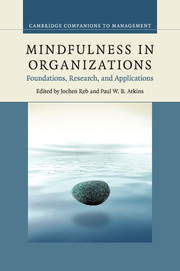Book contents
- Frontmatter
- Contents
- List of figures
- List of tables
- List of contributors
- Foreword
- Preface
- Part I Foundations
- 1 Introduction
- 2 What is mindfulness, and why should organizations care about it?
- 3 Mindfulness: historical and contemplative context and recent developments
- 4 Methods of mindfulness: how mindfulness is studied in the workplace
- 5 Applying mindfulness in the context of work: mindfulness-based interventions
- Part II Research
- Part III Applications
- Index
- References
3 - Mindfulness: historical and contemplative context and recent developments
from Part I - Foundations
Published online by Cambridge University Press: 05 July 2015
- Frontmatter
- Contents
- List of figures
- List of tables
- List of contributors
- Foreword
- Preface
- Part I Foundations
- 1 Introduction
- 2 What is mindfulness, and why should organizations care about it?
- 3 Mindfulness: historical and contemplative context and recent developments
- 4 Methods of mindfulness: how mindfulness is studied in the workplace
- 5 Applying mindfulness in the context of work: mindfulness-based interventions
- Part II Research
- Part III Applications
- Index
- References
Summary
Introduction
The world is all-abuzz nowadays about mindfulness. This is a wonderful thing because we are sorely lacking, if not starving for some elusive but necessary element in our lives.
(Kabat-Zinn 2011 p. 9).
The buzz Kabat-Zinn referred to shows no sign of dying down. If anything, it is growing and more and more large organizations appear to be including one or more elements of mindfulness training in their offering to employees (Gelles 2012). What an extraordinary journey the practice of mindfulness has made from the monasteries of Asia where it resided almost exclusively for 2,500 years to the “Mindful Leadership” sessions led by Janice Marturano at the World Economic Forum in Davos (Marturano 2013).
The concept of mindfulness as it is being used in this chapter emerges from the Buddhist tradition, but the mindfulness-based approaches and interventions that are found in organizational contexts today generally take an entirely secular approach. The aim of this chapter is to explore how mindfulness training has evolved from being set within traditional religious contexts to a more secular and modern approach. Emphasis is given to mindfulness programs derived from Buddhist teachings, in particular the mindfulness-based stress reduction (MBSR) course, which is currently the most prevalent and well-researched mindfulness intervention used in organizational contexts. A brief overview of major current theories and programs on mindfulness is provided along with suggestions for future research. Our aim is to provide a description of the most widely used approach to mindfulness training and to help the reader understand why it is designed as it is. We contend that it is critical to understand where ideas and practices associated with mindfulness have come from in order to understand where the mindfulness movement might be going, particularly in relation to organizational life.
The word “mindfulness” can be used to describe both an outcome – mindful awareness; and a process – mindful practice (Shapiro and Carlson 2009).
Information
- Type
- Chapter
- Information
- Mindfulness in OrganizationsFoundations, Research, and Applications, pp. 42 - 66Publisher: Cambridge University PressPrint publication year: 2015
References
Accessibility standard: Unknown
- 7
- Cited by
